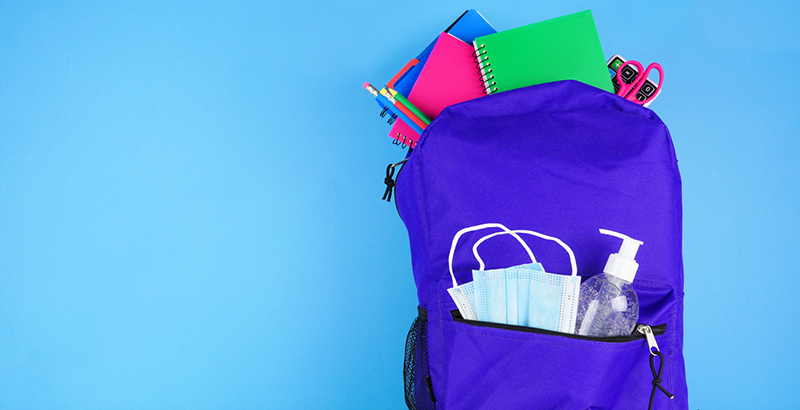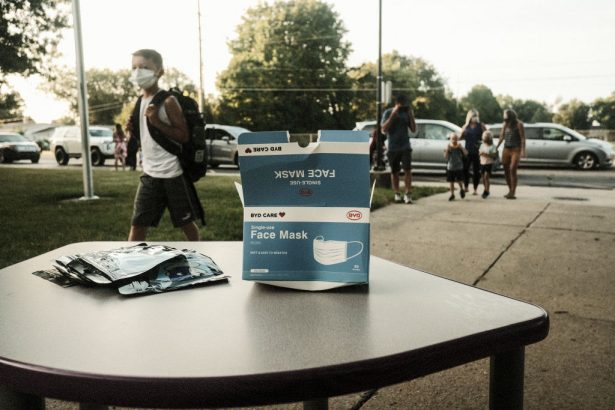The Week in COVID & Education Policy: Doctors Say Masks Should Be Optional in School, Learning Gaps Grew During Omicron and More Key Updates

This is our weekly briefing on how the pandemic is shaping schools and education policy, vetted, as always, by AEI Visiting Fellow John Bailey. Click here to see the full archive. Get this weekly roundup, as well as rolling daily updates, delivered straight to your inbox — sign up for The 74 Newsletter.
Schools Can Now Safely Make Masks Optional With the CDC’s New Guidelines: Op-ed by three physicians
- “Respirators and other high-quality masks are highly effective at protecting their wearers, regardless of what people around them are doing. … As a result, schools can finally safely make masks optional for students and staff.”
- “Maintaining aggressive mitigation policies, including strident mask rules, also sends children, families and staff the message that schools are not safe. This is simply not true.”
- “Everyone now has tools to protect themselves from severe disease, or any infection, if they so choose. Making this shift [top optional masking] also respects that people will have different risk tolerance levels.”
- “It’s time we stopped worrying about what others are doing and started focusing on protecting ourselves. We have many more tools in 2022 than we did in 2020, and our policies should shift to reflect these advances.”
- More from The Atlantic: The Case Against Masks at School
- “We reviewed a variety of studies — some conducted by the CDC itself, some cited by the CDC as evidence of masking effectiveness in a school setting and others touted by media to the same end — to try to find evidence that would justify the CDC’s no-end-in-sight mask guidance for the very-low-risk pediatric population, particularly post-vaccination. We came up empty-handed.”
- “This isn’t to say that these studies conclusively demonstrate that masks have no benefit in schools, but that any effect they have, if they have one, is tangled up in these other variables.”
- “Imposing on millions of children an intervention that provides little discernible benefit, on the grounds that we have not yet gathered solid evidence of its negative effects, violates the most basic tenet of medicine: First, do no harm.”

The Big Three — January 28, 2022
Education Recovery Hub: The Collaborative for Student Success, Center on Reinventing Public Education and the Edunomics Lab at Georgetown University launched a new site identifying innovative education practices.

K-Shaped Academic Recovery: With Omicron, another inequitable shock in math learning: Via Zearn
- “One of the evident consequences: a troubling re-emergence of a gap in participation in math learning between students in low- and high-income schools.”
- “This most recent K-shaped missed learning shows that students in low-income communities are experiencing a new and significant impact to their learning during this period of disruption — while students in more affluent communities are largely unaffected. This new finding comes on the heels of the reported five months of learning loss low-income students have already experienced as a result of the pandemic.”
- More details from The 74’s Beth Hawkins
Testing as an Alternative to Quarantining: Key Considerations and Best Practices for Implementing Test to Stay: New resource from Rockfeller and Duke universities. The issue brief highlights case examples from Illinois, Massachusetts and North Carolina’s Test to Stay programs.
- The brief also identifies four keys to success to help state and local officials overcome the challenges of Test to Stay programs:
- Fund and Staff Adequately: Successful schools received funding quickly and efficiently hired appropriate staff members to help administer their programs.
- Give More to Existing Underfunded Schools: States reallocated funds and staff to ensure that traditionally underfunded schools had adequate funding and staffing.
- Help Parents and Students Understand: Successful schools prioritized communicating their Test to Stay program to parents and students, including its benefits, how it would work and why it is safe.
- Consider Cultural Differences: Successful schools developed culturally appropriate responses that account for local contexts and parental views.
Federal Updates
Federal Communications Commission: Commits another $240 million in Emergency Connectivity Funding. Total commitments to date are supporting over 10,500 schools, 860 libraries and nearly 120 consortia for nearly 9.6 million connected devices and nearly 4.9 million broadband connections.
Education Department: Is hosting COVID Testing in K-12: A “How-To” Webinar on Jan. 28 and Feb 4.
City & State News
Arizona:
- A for Arizona launches $6 million grant opportunity for innovative public schools
- As COVID closed Arizona’s classrooms, Black mothers launched their own microschools with focus on personalized learning, ending school to prison pipeline
Hawaii: Public school student absences up dramatically in latest COVID-19 surge.
Illinois: Under a new statewide compromise, public school and higher education employees won’t have to expend their sick time if they are forced to miss work due to COVID-19 — as long as they’re fully vaccinated.
Maryland: The Maryland Department of Health launched a campaign — “Real Kids-Because I Said So“— to encourage parents to get their eligible children vaccinated against COVID-19.
Massachusetts: Boston has a dashboard of air filtration, ventilation and CO2 monitoring for all schools, down to the classroom in some cases — a brilliant way of not only providing transparency to parents and teachers, but monitoring for COVID risk.
Missouri: Attorney general sues 40-plus schools over mask mandates.
Texas: Starting next fall, Dallas Independent School District will be rolling out a full-time virtual school for third- through ninth-graders.
Virginia:
- Parents react: Gov. Glenn Youngkin repeals mask mandate in schools.
- Youngkin op-ed: Virginia’s parents can decide what’s best for their children.
- Youngkin announces updated guidelines for parents, educators and preK-12 schools. Guidance here, along with an infographic of the “algorithm” parents should use.
- Seven school boards sue to stop Youngkin’s mask-optional order on the day it takes effect.
- Andrew Rotherham reacts.
- A couple of additional thoughts: The guidance is a bit confusing, in part because it doesn’t link to or reference any studies to back up various claims and recommendations. For example, it says, “When the following prevention model has been implemented, studies have shown that infections and outbreaks in schools were reduced,” but there’s no model provided and literally no links/citations to anything that shows a reduction elsewhere. The ventilation guidance also has some inaccuracies.
COVID-19 Research
Omicron Is a Bigger Risk for the Young, Medical Data Shows: Study. More via Bloomberg.
- “The Omicron variant may be more dangerous for children than earlier coronavirus strains, a study of hospitalization data from one of South Africa’s biggest medical insurance programs showed.”
- “Data from the 56,164 COVID-19-related hospital admissions among the more than 2 million beneficiaries of the Government Employees Medical Scheme found that the admission rate for children under the age of 4 was 49% higher during the Omicron wave than for Delta. It was also higher than during the infection surges driven by the original virus and the Beta variant, according to the data analyzed by the National Institute for Communicable Diseases. In addition, admissions were 25% higher for those aged 4 to 18 than in the Delta wave, although lower than for Beta, it showed.”
BA.2: There were a number of stories last weekend related to BA.2, which is often referred to as “stealth Omicron” because some PCR tests can’t distinguish it from other variants due to a unique mutation.
- The U.K. labeled BA.2 a “Variant Under Investigation (VUI),” due to its doubling every four days which equates to a 120% growth advantage over BA.1.
- In Denmark, BA.2 has displaced BA.1 and now accounts for almost half of the new infections in the country. Early data suggests there hasn’t been an uptick in hospitalizations since the subtype took hold.
- VUI is the lowest level of classification, meaning it’s something to watch, not worry about right now.
Israeli Study Finds Rate of Heart Problems in Vaccinated Boys Slightly Higher Than Expected: “Boys between 12 and 15 years of age have a small but increased risk of heart problems after receiving the second dose of the Pfizer-BioNTech vaccine, Israeli researchers reported.”
- “Myocarditis, or inflammation of the heart muscle, occurred in 1 of 12,361 boys of this age group within a week of receiving the second dose, the study found. The cases were mild, and the side effect remains uncommon.”
Morning Consult/New York Times Survey: With some interesting data points:
- Only about half of parents are comfortable with in-person learning.
- More than 1 in 3 parents believe schools are opening too quickly.
- How certain or uncertain are you that each of the following will occur? We will learn how to live with COVID-19 and its variants without having to disrupt daily life: 66% Certain / 28% uncertain
- Do you support or oppose the following initiatives taking effect in your community?
- Requiring students to wear masks in schools: 68% support / 26% oppose.
- Requiring students to be vaccinated against COVID-19 to attend school in-person: 55% support / 38% oppose
- Transitioning students from in-school to online learning: 48% support / 41% oppose
- The NYT has more
Parents More Concerned About Their Child Missing School Than Catching COVID: NBC News poll:
- Are you more concerned about children going to school in person resulting in more spreading of the coronavirus, or more concerned about children not going to school in person and falling behind in their education?
- Total more concerned about spreading of coronavirus: 30%
- Total more concerned about falling behind in their education: 65%
Children and COVID-19: State-Level Data Report from American Academy of Pediatrics
- More than 1.1 million cases were reported, nearly five times the rate of the peak of last winter’s surge.
- For the week ending Jan. 20, nearly 1.15 million child COVID-19 cases were reported. This number is a 17% increase over the 981,000 added cases reported the week ending Jan. 13 and a doubling of case counts from the two weeks prior.
COVID-19: Endemic Doesn’t Mean Harmless: Essay in Nature. A “disease can be endemic and both widespread and deadly. Malaria killed more than 600,000 people in 2020. Ten million fell ill with tuberculosis that same year and 1.5 million died. Endemic certainly does not mean that evolution has somehow tamed a pathogen so that life simply returns to ‘normal’.”
COVID Virus Linked with Headaches, Altered Mental Status in Hospitalized Kids: According to a study led by a pediatrician-scientist at UPMC and the University of Pittsburgh School of Medicine.
What Now? How Pandemics End: Via Katelyn Jetelina
- What’s next?
- Omicron infection will help, but we don’t know for how long.
- The virus will mutate, but we don’t know how.
- There has to be a global response.
- How do we prepare?
- Increase vaccine uptake.
- Continue to wear masks. “Masks, on average, reduce transmission by 56%.”
- Invest in better filtration systems.
- Scale up antigen testing.
- Increase supply of therapeutics.
- Strengthen surveillance.
- Communicate. “We desperately need top-down communication. The CDC needs to come out from hiding and let their experts talk. We need weekly updates. But, more than that, we need a plan. We need to develop and communicate off-ramps and goals. If public health officials don’t, then other people will. And, when we don’t like their plan, we have no right to complain.”
Pfizer: CEO sees annual COVID vaccine rather than frequent boosters.
New Research Shows How Bad the Pandemic Has Been for Student Mental Health: Via EdWeek
The End of K-12 Contact Tracing? Some Schools Say Symptoms, Not Exposure, Should Spur Tests: Via The 74
UK Study Suggests Two-Thirds Infected With Omicron Had COVID Before: Real-time Assessment of Community Transmission Findings out of the UK
Viewpoints
Schools May Be Open — But They’re Struggling: Via The Wall Street Journal.
- “The problem [at Brooklyn Tech] and in many other schools boils down to a mismatch between demand and supply. While many officials and parents nationwide push to keep kids in school and away from remote learning, Omicron has left many schools short of the essentials needed to operate, like teachers, substitutes, bus drivers, cafeteria workers — and sometimes students themselves.”
- “The result is a sort of low-grade chaos. Teachers improvise Zoom classes for those who are absent. Some students try to teach others who have missed long stretches. Students give themselves COVID tests in crowded hallways.”
- “To improve ventilation in their stuffy, prewar building, Brooklyn Tech teachers have been instructed to open windows at least 3 inches. Under city rules, two to three windows in a classroom should be open 3 inches or one window in a room should be open 6 inches.”
- “When temperatures fell to 17 degrees this month, students took to wearing coats in an anthropology class. ‘It’s like you lose focus,’ said senior Alex Atack, 17. ‘I swear to God, my toes went numb last week. It was so cold.’”
Students Are Walking Out Over COVID: Via The Atlantic.
- “The students [in Texas] are requesting, among other things, that their schools notify them if they’ve been exposed to a COVID-positive classmate, enforce the mask mandate and provide KN95 or N95 masks to students (the district currently provides surgical masks). They also want the option to voluntarily go remote until those demands are met.”
- “What’s more, a couple of students I spoke with said that they knew of classmates who had tested positive but gone to school anyway, and that students have been on their own in determining whether they’ve been exposed. They effectively have had to work as their own informal contact-tracing teams, asking around about peers’ test results and monitoring social media for indications of COVID cases.”
‘My Freshmen Are More Like 7th Graders’: Inside the Omicron-Era Classroom: Via Esquire, with some really interesting interviews with teachers.
SAT Moves Online: The College Board announced that the SAT will be delivered digitally in 2024.
4 Education Policy Tools to Use in 2022: Via Education Commission of the States
…And on a Snowier Note
Seven Springs Resort Ski Update: From Abbey Way:
- 1 inch of natural snow overnight
- 16 inches of snow this week
- 21 slopes and trails
- 1 person struggling to walk down the stairs.
Abbey actually tracked down the “Struggling Skier” and provided an update.
You asked, we delivered. Struggling Skier/Mrs Bean is here with an update.https://t.co/76HbQ32OCS pic.twitter.com/GW3Nsii8eV
— Seven Springs (@7SpringsPA) January 22, 2022
ICYMI @The74
Weekend Reads: In case you missed them, our top stories of the week:
- New York City: NYC schools reported over 9,600 students to child protective services since Aug. 2020. Is it the ‘wrong tool’ for families traumatized by COVID?
- Masking: Kids wearing masks reduces child care center closures, year-long Yale study finds
- Media Literacy: As misinformation rages, educators focused on improving news literacy turn to outside groups to help kids parse fact from fantasy
- COVID Recovery: ‘Essentially abdicating their role’: Report finds states lack plans for ensuring schools spend pandemic aid on the kids who need it most
- Commentary: After 2 years of uncertainty and shaken trust, America’s relationship with its public schools is in play like never before
For even more COVID policy and education news, subscribe to John Bailey’s daily briefing via Substack.
Disclosure: John Bailey is an adviser to the Walton Family Foundation, which provides financial support to The 74.
Get stories like these delivered straight to your inbox. Sign up for The 74 Newsletter

;)
